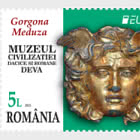Romfilatelia, the company specialized in editing and trading Romanian postage stamps, introduces into circulation the postage stamps issue ROMANIAN POTTERY - Peasant dishes (II).
The black ceramics, of Dacian origin, had a major spreading in pre-Roman Dacia. In order to obtain the black colour, the paste is subject to an incomplete burning (oxygen reducing burning), by smothering the oven at a certain moment. Burning is done in holes of the shape of cone frustum with the narrowed area on the upper side, deep up to 1.5 m. Adjacently, a hole is dug that communicates with the first one by a small canal and where the fire is set. The clay items are placed in the taper hole. When they are burnt enough and get a red colour, they are covered with a thick layer of damp clay, with which the connecting canal between the holes is also stopped up. Therefore, burning continues in the absence of oxygen and the vessels get a grey or black colour.
The black ceramics is still made even nowadays in Romania, in Marginea, county of Suceava, in Poiana Deleni, Iasi or in Madaras, Harghita. In the case of black ceramics, decoration is done by polishing it with a special stone.
The red ceramics, obtained by burning in the oxidizing system, has borrowed and perpetuates elements of Roman tradition. The decoration is made by painting with the brush or horn, through operations that bear handicraft names such as: "jiravire cu gaita" (spider web decoration style), "stropire cu maturica" (whisk splattering) or by incision in the damp clay or by embossing some clay strands.
The plates (dishes or flat plates) are decorated using colours obtained naturally, based on ancient knowledge. Red is obtained from an earth rich in iron oxide (called "ruseala"), that can be found in the valleys, at depths of 2-3 m. The oxide is dried up, finely pounded, ground and dipped into water. Thus, a viscous fluid is obtained that is filtered through canvas or sieve, hence resulting a glossy substance. Black is obtained from a special earth, extracted from the earth erosions after rains. Green is obtained from the slag produced by burning copper wire into the oven. The slag resulted is peeled, pounded, finely ground and blended with the clay. White is obtained from lime blended with mountain white stone, burnt and pounded. Yellow is extracted from Medgidia clay (having a limited area of spreading), blended with "ruseala".
On the postage stamp with the face value of Lei 0.70 a peasant dish made in Vladesti-Valcea is illustrated.
On the postage stamp with the face value of Lei 0.80 a peasant dish made in Vistea-Brasov is illustrated.
On the postage stamp with the face value of Lei 1.60 a peasant dish made in Tansa-Iasi is illustrated.
On the postage stamp with the face value of Lei 3.10 a peasant dish made in Romana-Olt is illustrated.












































